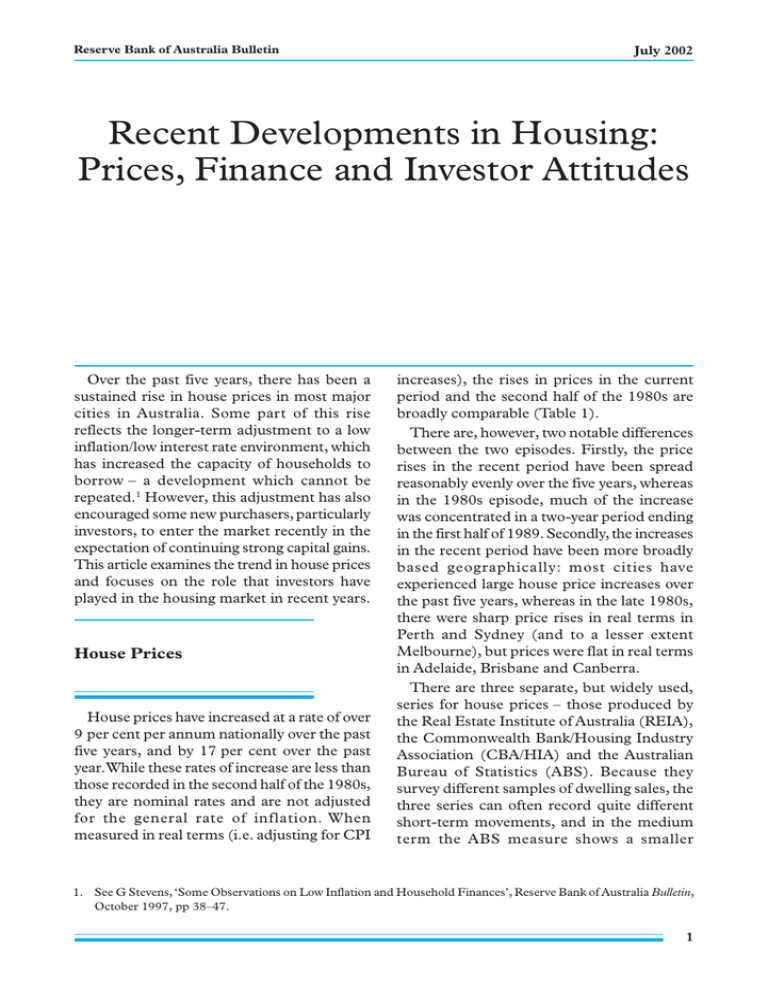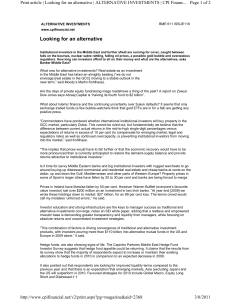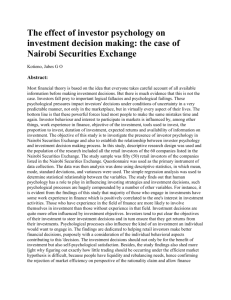Recent Developments in Housing: Prices, Finance and Investor Attitudes
advertisement

Reserve Bank of Australia Bulletin July 2002 Recent Developments in Housing: Prices, Finance and Investor Attitudes Over the past five years, there has been a sustained rise in house prices in most major cities in Australia. Some part of this rise reflects the longer-term adjustment to a low inflation/low interest rate environment, which has increased the capacity of households to borrow – a development which cannot be repeated.1 However, this adjustment has also encouraged some new purchasers, particularly investors, to enter the market recently in the expectation of continuing strong capital gains. This article examines the trend in house prices and focuses on the role that investors have played in the housing market in recent years. House Prices House prices have increased at a rate of over 9 per cent per annum nationally over the past five years, and by 17 per cent over the past year. While these rates of increase are less than those recorded in the second half of the 1980s, they are nominal rates and are not adjusted for the general rate of inflation. When measured in real terms (i.e. adjusting for CPI increases), the rises in prices in the current period and the second half of the 1980s are broadly comparable (Table 1). There are, however, two notable differences between the two episodes. Firstly, the price rises in the recent period have been spread reasonably evenly over the five years, whereas in the 1980s episode, much of the increase was concentrated in a two-year period ending in the first half of 1989. Secondly, the increases in the recent period have been more broadly based geographically: most cities have experienced large house price increases over the past five years, whereas in the late 1980s, there were sharp price rises in real terms in Perth and Sydney (and to a lesser extent Melbourne), but prices were flat in real terms in Adelaide, Brisbane and Canberra. There are three separate, but widely used, series for house prices – those produced by the Real Estate Institute of Australia (REIA), the Commonwealth Bank/Housing Industry Association (CBA/HIA) and the Australian Bureau of Statistics (ABS). Because they survey different samples of dwelling sales, the three series can often record quite different short-term movements, and in the medium term the ABS measure shows a smaller 1. See G Stevens, ‘Some Observations on Low Inflation and Household Finances’, Reserve Bank of Australia Bulletin, October 1997, pp 38–47. 1 July 2002 Recent Developments in Housing: Prices, Finance and Investor Attitudes Table 1: House Prices Percentage change over five years Sydney Melbourne Brisbane Perth Adelaide Canberra Darwin Hobart Australia(b) Nominal Real(a) Five years to: Five years to: March 1989 March 2002 March 1989 March 2002(c) 140.4 122.2 47.9 142.0 43.9 42.8 na na 114.1 45.2 89.3 62.0 37.1 42.3 49.8 14.0 27.3 56.9 68.0 55.3 3.4 69.1 0.6 –0.2 na na 49.6 30.7 70.5 45.8 23.5 28.1 34.8 2.7 14.6 41.2 Source: REIA (a) Deflated by the CPI excluding interest charges, adjusted for tax changes and the introduction of Medicare (b) Chain-weighted by number of capital-city households (c) House price data for March 1997 interpolated increase than the others, as it takes more account of the changing composition of the housing stock being transacted each quarter.2 Notwithstanding the problems of measurement, falls in aggregate house prices appear to have been rare. Within the past few years, the only quarterly decline in prices was recorded in the September quarter of 2000, but this is likely to be due to compositional effects associated with the response to the GST and the measures which accompanied it. In subsequent quarters, the three series show a succession of strong quarterly rises, although other data – particularly auction clearance rates – suggest that the housing market quietened for a time in the second half of 2001, probably in response to the increased uncertainty about international economic and financial prospects following 11 September. In 2002, however, the housing market bounced back, with prices, finance and activity rising quickly. Housing Finance Over the past five years, the stock of loans outstanding for housing has grown at an average annual rate of 141/2 per cent. This is a good deal faster than lending in total which has grown by 101/2 per cent (Graph 1). One result of this is that Australian banks now have as much lending exposure to housing as to the business sector. In addition to the banks, building societies and mortgage originators (including the new participants known as non-conforming lenders) have been very active in providing housing finance. The upshot of this is that the household sector is carrying considerably more housing debt now than it was a decade ago. The housing finance data include loans both to owner-occupiers and to investors. Both 2. The ABS series also excludes the top and bottom parts of the distribution of dwelling prices in its calculations. 2 Reserve Bank of Australia Bulletin July 2002 Graph 1 Credit Growth Year-ended percentage change % % Housing 20 20 15 15 10 10 Total 5 5 0 0 -5 -5 1990 1993 1996 1999 2002 Source: RBA types of lending have grown quite quickly, but the increase in loans to investors has been especially strong. Since 1990, bank lending to investors has grown at an annual rate of 21 per cent, compared with 131/2 per cent for lending to owner-occupiers. As a result, the share of investor loans in the banks’ total stock of housing loans has risen from 15 per cent in 1990 to 31 per cent in 2001. The next section explores the increase in investor activity in more detail. Lending to Investors Borrowing for investment in residential property has been a common investment strategy in Australia for many years. Historically, a growing population has ensured long-term growth in the demand for housing. In recent years, population growth has begun to slow, but this has been broadly offset by an increased rate of household formation. In addition, changing tastes have increased the demand for apartment-style accommodation close to the centre of major cities, which has seen considerable construction activity. The interaction of high inflation and taxation arrangements was for many years one of the most powerful factors making property investment attractive for investors. High inflation underpinned rising dwelling prices, and so made significant nominal capital gains the norm. Combined with tax-deductibility of interest costs, and the ability to negatively gear the investment, i.e. deduct from taxable income the excess of interest payments over rental receipts, this made investment housing quite tax effective, although the introduction of capital gains tax in 1985 provided some offset. Negative gearing provides a strong incentive to maximise the debt component of financing and minimise the equity component. As a result, a sizeable share of the financing to investors has been in the form of interest-only loans, rather than conventional loans (involving gradual repayment of principal) which dominate the owner-occupied market. For the past 10 years, general inflation has been quite low, thereby reducing the extent of the attraction resulting from the interaction of tax and inflation. Nonetheless, large capital gains on housing assets have occurred in this period of transition from a high interest rate to a low interest rate environment. It is worth noting in passing that most housing loans, whether for investment or owner-occupation, are used to purchase existing dwellings rather than build new ones. There are, however, two measures in the tax system which give investors some incentive to choose new dwellings rather than old, so adding to the stock of housing. First, investors can depreciate new dwellings by 21/2 per cent per annum;3 this is not possible for older buildings, nor for owner-occupiers.4 Secondly, 3. The depreciation allowance was introduced in 1985, when the scope for negative gearing was reduced by quarantining the interest cost offset to rental income. The rate of depreciation was decreased from 4 per cent per annum to its current level of 2.5 per cent in 1987, when this quarantining was removed and full negative gearing was reinstated. According to the Australian Tax Office, in 1998/99, around 20 per cent of property investors claimed this depreciation allowance. 4. Investment dwellings are, however, subject to capital gains tax whereas owner-occupied dwellings are not. 3 July 2002 Recent Developments in Housing: Prices, Finance and Investor Attitudes in Victoria, it is possible to substantially reduce stamp duty if a dwelling is bought before completion – so-called ‘off-the-plan’ purchasing. Investor activity has also been stimulated by developments on the supply side. In the 1970s and 1980s, housing investors faced less favourable borrowing conditions in that banks and building societies were reluctant to lend to them. Banks also charged investors higher interest rates than owner-occupiers.The result of these various constraints was that many housing investors had to resort to less conventional lending sources, such as solicitors’ funds, insurance companies and stockbrokers. In the 1980s, regulations on interest rates and bank lending behaviour were gradually removed. In the 1990s, increased competition, securitisation and new entry into the industry saw a substantial increase in the availability of finance for investors. Banks now actively seek housing investors, interest rates on loans to investors are no longer any higher than on those to owner-occupiers (Graph 2), and new mor tgage providers such as mortgage originators and brokers, in partnership with property developers, approach potential housing investors. It is not surprising, therefore, that there has been a steady trend towards greater borrowing for investor housing over the past decade. The prominence of investor activity in the housing market has grown exceptionally quickly, however, over the past 18 months or so. Since the trough in loan approvals in October 2000, the total monthly value of housing loans approved has increased by $4.4 billion. Over the same period, the monthly value of approvals for investor housing loans has risen by $2.4 billion. That is, loans to investors have accounted for more than half the pick-up in monthly loan approvals in the current upswing in the housing cycle. Graph 3 shows that in the current episode, monthly loan approvals for investment purposes have risen by 113 per cent, compared with 48 per cent for owner-occupation. 4 Graph 2 Housing Loan Rates Spread over cash rate % % 5 5 Investor 4 4 3 3 Owner-occupier 2 2 1 1 1992 1994 1996 2000 1998 2002 Source: RBA Graph 3 Housing Loan Approvals Seasonally adjusted $b Investor Owner-occupier 6 $b 6 Rise since trough 113% 48% 4 4 2 2 0 0 1998 2000 2002 2000 2002 Source: ABS So in addition to the factors making for a trend increase in investor activity, there must have been other factors at work in the most recent period. In this regard, one factor may well have been the growing perception that returns in the share market will be lower than those seen in the preceding five years or so, with the implication that investment in property is preferable in terms of risk and return. The strong rise in house prices that has occurred over a number of years now is likely to have contributed to that perception, particularly if expectations about future gains are formed in an extrapolative fashion. A Reserve Bank of Australia Bulletin similar situation occurred in the late 1980s after the 1987 share market decline when there was a surge in lending to investors in 1988 and 1989. Of course, previous capital gains are no guarantee of future gains. The large increase in supply of properties to the rental market which is occurring at present must raise some doubts about the prospects for returns on this type of investment over the next several years. The next section looks at the rental market in more detail. July 2002 Graph 4 Rental Vacancy Rate % % 4 4 3 3 2 2 1 1 0 1982 The Rental Property Market There is no simple separation of the housing market into the part owned by investors and the part owned by owner-occupiers. While investors concentrate their purchases on the medium-density market, some also buy free-standing houses. Similarly, although owner-occupiers account for most of the free-standing houses, many choose to purchase in the medium-density market.That being said, it is still probably true that investors exert a disproportionate influence in the medium-density market. Despite the faster growth of lending to investors over the past five years, the construction of medium-density housing has not significantly outpaced that of free-standing houses. It is only very recently that approvals to build medium-density housing have been at a high level, whereas approvals to build free-standing housing have declined a little. Vacancy rates for rental property have increased over recent years, suggesting that the supply of such property is outstripping the demand (Graph 4). Further evidence for this is found in the continuing fall in rental yields – that is, the ratio of average rent to the average price of a dwelling (Graph 5). Over a long period, the rental yield – which is a real yield – has tended to decline, as rents have not kept pace with price gains. During the 1990s at least, some of this might be seen as occurring broadly in line with the 1987 1992 1997 0 2002 Source: REIA Graph 5 Gross Rental Yield* % % 9 9 8 8 7 7 6 6 5 5 4 4 3 1986 1990 1994 1998 3 2002 * Median annual rent as proportion of median house price Sources: REIA; RBA trend decline which occurred in the real yields on financial assets. To this extent, a run-up in the price of houses is to be expected. But the rise in prices appears to have accelerated in the latest year, even as an imbalance between supply and demand has started to emerge. Supply of accommodation is increasing, and will continue to do so in the year or two ahead with the completion of a large number of recently approved medium-density dwellings. Demand, on the other hand, may have declined at the margin, as owner-occupation became more readily attainable as a result of the Commonwealth Additional Grant Scheme. 5 Recent Developments in Housing: Prices, Finance and Investor Attitudes In the early 1990s, high vacancy rates were associated with a decline in rents. This historical experience suggests that in the current environment, prospective yields on rental properties may be lower than those seen to date. It would be unlikely that further strong 6 July 2002 price increases could co-exist with rising vacancy rates and falling rental yields for very long. It is more likely that any assumption by investors that future capital gains can be assured will have to undergo some revision.R







